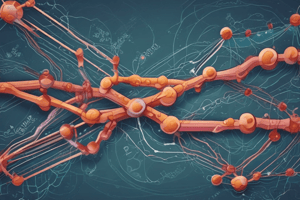Podcast
Questions and Answers
What is the characteristic feature of eicosanoids in terms of their carbon chain?
What is the characteristic feature of eicosanoids in terms of their carbon chain?
- They have a 20-carbon chain (correct)
- They have a 10-carbon chain
- They have a 15-carbon chain
- They have a varying number of carbons
What is the term used to describe the type of signaling that eicosanoids are involved in?
What is the term used to describe the type of signaling that eicosanoids are involved in?
- Paracrine signaling (correct)
- Endocrine signaling
- Synaptic signaling
- Autocrine signaling
What is the precursor molecule for eicosanoids?
What is the precursor molecule for eicosanoids?
- Cholesterol
- Arachidonic acid (correct)
- Fatty acid
- Sterol
What is the characteristic feature of sterols in terms of their molecular structure?
What is the characteristic feature of sterols in terms of their molecular structure?
What is the term used to describe lipids that contain both polar and nonpolar parts?
What is the term used to describe lipids that contain both polar and nonpolar parts?
What is the function of bile salts based on their molecular structure?
What is the function of bile salts based on their molecular structure?
What is the relationship between sterols and other lipids?
What is the relationship between sterols and other lipids?
What is the term used to describe the type of bonds found in sterols?
What is the term used to describe the type of bonds found in sterols?
What is the immediate precursor of fatty acids in lipid synthesis?
What is the immediate precursor of fatty acids in lipid synthesis?
What was the reason behind the Air Ministry's claim that British pilots were eating lots of carrots during WW2?
What was the reason behind the Air Ministry's claim that British pilots were eating lots of carrots during WW2?
Where does the synthesis of longer chain fatty acids take place?
Where does the synthesis of longer chain fatty acids take place?
What is the function of vitamin D in the body?
What is the function of vitamin D in the body?
What is the intermediate in the synthesis of sterols from acetate?
What is the intermediate in the synthesis of sterols from acetate?
Which type of cells do not have an Endoplasmic Reticulum?
Which type of cells do not have an Endoplasmic Reticulum?
What is the connection between a lack of vitamin D or calcium and a specific bone disorder?
What is the connection between a lack of vitamin D or calcium and a specific bone disorder?
What is the medical use of vitamin K?
What is the medical use of vitamin K?
What is the building block of lipids?
What is the building block of lipids?
What is the precursor molecule for vitamin D?
What is the precursor molecule for vitamin D?
How are fatty acids built?
How are fatty acids built?
What is the enzyme responsible for making Palmitate?
What is the enzyme responsible for making Palmitate?
What is the primary function of bile salts in the digestive system?
What is the primary function of bile salts in the digestive system?
What is the resulting compound formed from the modification of 7-dehydrocholesterol?
What is the resulting compound formed from the modification of 7-dehydrocholesterol?
What is the primary function of bile salts in the digestive system?
What is the primary function of bile salts in the digestive system?
What is the structure of Palmitate?
What is the structure of Palmitate?
What is the characteristic feature of amphipathic lipids?
What is the characteristic feature of amphipathic lipids?
Which type of vitamins are fat-soluble?
Which type of vitamins are fat-soluble?
What is the characteristic feature of amphipathic lipids?
What is the characteristic feature of amphipathic lipids?
What is the primary function of steroid hormones in the body?
What is the primary function of steroid hormones in the body?
What is the characteristic feature of Vitamin A (Retinol)?
What is the characteristic feature of Vitamin A (Retinol)?
What is the relationship between sterols and other lipids?
What is the relationship between sterols and other lipids?
What is the function of steroid drugs?
What is the function of steroid drugs?
What is the primary difference between water-soluble and fat-soluble vitamins?
What is the primary difference between water-soluble and fat-soluble vitamins?
What is the primary function of eicosanoids in the body?
What is the primary function of eicosanoids in the body?
Which type of lipid is characterized by the presence of a hydrocarbon chain and a carboxyl group?
Which type of lipid is characterized by the presence of a hydrocarbon chain and a carboxyl group?
What is the primary function of bile salts in the body?
What is the primary function of bile salts in the body?
Which of the following is an example of an amphipathic lipid?
Which of the following is an example of an amphipathic lipid?
What is the primary function of sterol derivatives in the body?
What is the primary function of sterol derivatives in the body?
Which type of lipid is responsible for the absorption of lipid-soluble vitamins?
Which type of lipid is responsible for the absorption of lipid-soluble vitamins?
What is the energy yield of each gram of fat when oxidized?
What is the energy yield of each gram of fat when oxidized?
What is the primary function of fatty acid derivatives in the body?
What is the primary function of fatty acid derivatives in the body?
What is the primary purpose of cell-cell signalling?
What is the primary purpose of cell-cell signalling?
What is the role of the responding cell in cell signalling?
What is the role of the responding cell in cell signalling?
What is the difference between paracrine and autocrine signalling?
What is the difference between paracrine and autocrine signalling?
What is the result of a cell responding to a signal?
What is the result of a cell responding to a signal?
How do some signals affect the responding cell?
How do some signals affect the responding cell?
What is the purpose of signal transduction?
What is the purpose of signal transduction?
What is the difference between endocrine and paracrine signalling?
What is the difference between endocrine and paracrine signalling?
How does the signal enter the cell?
How does the signal enter the cell?
What type of receptors are activated by signals that can pass through the plasma membrane?
What type of receptors are activated by signals that can pass through the plasma membrane?
What is the role of Hsp chaperones in nuclear receptors?
What is the role of Hsp chaperones in nuclear receptors?
What is the result of GDP being replaced by GTP in G-protein linked receptors?
What is the result of GDP being replaced by GTP in G-protein linked receptors?
What is the role of type II receptors in serine/threonine kinase receptors?
What is the role of type II receptors in serine/threonine kinase receptors?
What is the result of ligand binding to nuclear receptors?
What is the result of ligand binding to nuclear receptors?
What is the role of Ga in G-protein linked receptors?
What is the role of Ga in G-protein linked receptors?
What is the result of Smads being phosphorylated in serine/threonine kinase receptors?
What is the result of Smads being phosphorylated in serine/threonine kinase receptors?
What is the characteristic of signals that activate nuclear receptors?
What is the characteristic of signals that activate nuclear receptors?
What is the primary purpose of cell-cell signalling?
What is the primary purpose of cell-cell signalling?
What is the role of the responding cell in cell signalling?
What is the role of the responding cell in cell signalling?
What is the main difference between paracrine and autocrine signalling?
What is the main difference between paracrine and autocrine signalling?
What is the result of a cell responding to a signal?
What is the result of a cell responding to a signal?
How do some signals affect the responding cell?
How do some signals affect the responding cell?
What is the purpose of signal transduction?
What is the purpose of signal transduction?
What is the main difference between endocrine and paracrine signalling?
What is the main difference between endocrine and paracrine signalling?
How do signals that can pass through the plasma membrane bind to their receptors?
How do signals that can pass through the plasma membrane bind to their receptors?
What type of receptors are involved in signaling through steroids or retinoids?
What type of receptors are involved in signaling through steroids or retinoids?
What is the function of Hsp chaperones in nuclear receptors?
What is the function of Hsp chaperones in nuclear receptors?
What happens to the G-protein in G-protein linked receptors after ligand binding?
What happens to the G-protein in G-protein linked receptors after ligand binding?
What is the role of Smads in serine/threonine kinase receptors?
What is the role of Smads in serine/threonine kinase receptors?
What is the difference between type I and type II receptors in serine/threonine kinase receptors?
What is the difference between type I and type II receptors in serine/threonine kinase receptors?
What is the result of G-protein activation in G-protein linked receptors?
What is the result of G-protein activation in G-protein linked receptors?
What is the role of Ga in G-protein linked receptors?
What is the role of Ga in G-protein linked receptors?
What happens to the GTP bound to the G-protein in G-protein linked receptors?
What happens to the GTP bound to the G-protein in G-protein linked receptors?
Flashcards are hidden until you start studying
Study Notes
Lipids
- Refers to a collection of organic molecules of varying chemical composition: fatty acids, glycerides, nonglyceride lipids, and complex lipids.
- Includes sterol derivatives.
Biological Functions of Lipids
- Energy source: each gram of fat releases 9 kcal of energy.
- Energy storage: in the form of triglycerides (TAG) in adipocytes.
- Cell membrane structural components: phosphoglycerides, sphingolipids, and steroids make up the basic structure of all cell membranes.
- Hormones: eicosanoids and steroid hormones.
- Vitamins: lipid-soluble vitamins (A, D, E, and K).
- Vitamin absorption: dietary fat serves as a carrier of lipid-soluble vitamins.
- Protection: fats as shock absorbers.
- Insulation: subcutaneous fat.
Eicosanoids
- Act as paracrine signals.
- Derived from arachidonic acid.
- Are drug targets.
Sterols and Derivatives
- Sterols are amphipathic (contain polar and nonpolar parts) and planar (flat).
- No rotation around carbon bonds.
- Cholesterol is a sterol derivative.
- Bile salts: derived from cholesterol, amphipathic, and enable fat absorption.
Synthesis of Lipids
- Lipids are built from acetate.
- Acetate is converted to Acetyl-Coenzyme A (Acetyl-CoA).
- Fatty acids and sterols are made from Acetyl-CoA.
- Fatty acids are built two carbons at a time.
- Palmitate is the precursor of fatty acids.
- Longer chain fatty acids are made by fatty acid elongation systems in the smooth ER.
Steroid Hormones
- Derived from sterol.
- Act as cellular messengers.
- Many drugs are steroid analogues.
- Examples: sex hormones (e.g., progesterone) and corticosteroids.
Vitamins
- Water-soluble vitamins: B class (1, 2, 3, 5, 6, 7, 9, 12) and C.
- Fat-soluble vitamins: A, D, E, and K.
- Vitamin A (Retinol): important in skin cells and vision.
- Vitamin D: made from 7-dehydrocholesterol, controls calcium metabolism.
- Vitamin K: used as an antidote against rat poison and as a treatment for anticoagulant overdose.
Cell Signalling
- Cell signalling is the communication between cells, involving a chemical messenger (signal/ligand) released by the signalling cell.
- The signal is detected by the responding cell (receptor), triggering intracellular reactions that influence the behaviour of the responding cell.
Tasks of Cell Communication
- Signal release: synthesis and excretion of the signalling molecule by the signalling cell.
- Signal detection: interaction of signal and receptor.
- Signal transduction: translation of detection to changes in cell physiology or gene expression.
Types of Signals
- Paracrine signals: act on a local set of cells.
- Autocrine signals: act on the secreting cell itself.
- Endocrine signals: long-range signals moving through the bloodstream.
Signalling and Control of Gene Expression
- Cell-cell signalling can change the repertoire of transcription factors in the responding cell, resulting in different gene expression.
- Some signals can form gradients, and cell fate depends on signal concentration.
Signal Entry into the Cell
- Two strategies for signal entry:
- The signal can pass through the plasma membrane (e.g., nuclear receptors).
- The signal can activate a membrane receptor (e.g., G protein linked receptors, Serine/threonine kinase receptors).
Nuclear Receptors
- Signals are steroids or retinoids.
- These signals can pass through the plasma membrane and encounter nuclear receptors in the cytoplasm.
- The receptor-ligand complex then enters the nucleus to activate genes.
Signalling through Nuclear Receptors
- Nuclear receptors like the glucocorticoid receptor are cytoplasmic proteins.
- In their inactive form, they are bound to Hsp chaperones.
- Ligand binding releases the Hsp, and the receptor-ligand complex moves to the nucleus to activate the transcription of target genes.
G-Protein Linked Receptors
- Transmembrane receptors are linked to a G-protein.
- Upon ligand binding, the G protein releases GDP and takes up GTP.
- Ga dissociates from Gbg and activates downstream 'second messengers' (e.g., cAMP).
- GTP is hydrolyzed to GDP, and Ga reassociates with Gbg.
Serine/Threonine Kinase Receptors
- Transmembrane receptors that bind the TGFb family of signals.
- Ligand brings together type I and type II receptors.
- Type II phosphorylates type I.
- Smads become phosphorylated and move into the nucleus to act as transcription factors.
Cell Signalling
- Cell signalling is the communication between cells, involving a chemical messenger (signal/ligand) released by the signalling cell.
- The signal is detected by the responding cell (receptor), triggering intracellular reactions that influence the behaviour of the responding cell.
Tasks of Cell Communication
- Signal release: synthesis and excretion of the signalling molecule by the signalling cell.
- Signal detection: interaction of signal and receptor.
- Signal transduction: translation of detection to changes in cell physiology or gene expression.
Types of Signals
- Paracrine signals: act on a local set of cells.
- Autocrine signals: act on the secreting cell itself.
- Endocrine signals: long-range signals moving through the bloodstream.
Signalling and Control of Gene Expression
- Cell-cell signalling can change the repertoire of transcription factors in the responding cell, resulting in different gene expression.
- Some signals can form gradients, and cell fate depends on signal concentration.
Signal Entry into the Cell
- Two strategies for signal entry:
- The signal can pass through the plasma membrane (e.g., nuclear receptors).
- The signal can activate a membrane receptor (e.g., G protein linked receptors, Serine/threonine kinase receptors).
Nuclear Receptors
- Signals are steroids or retinoids.
- These signals can pass through the plasma membrane and encounter nuclear receptors in the cytoplasm.
- The receptor-ligand complex then enters the nucleus to activate genes.
Signalling through Nuclear Receptors
- Nuclear receptors like the glucocorticoid receptor are cytoplasmic proteins.
- In their inactive form, they are bound to Hsp chaperones.
- Ligand binding releases the Hsp, and the receptor-ligand complex moves to the nucleus to activate the transcription of target genes.
G-Protein Linked Receptors
- Transmembrane receptors are linked to a G-protein.
- Upon ligand binding, the G protein releases GDP and takes up GTP.
- Ga dissociates from Gbg and activates downstream 'second messengers' (e.g., cAMP).
- GTP is hydrolyzed to GDP, and Ga reassociates with Gbg.
Serine/Threonine Kinase Receptors
- Transmembrane receptors that bind the TGFb family of signals.
- Ligand brings together type I and type II receptors.
- Type II phosphorylates type I.
- Smads become phosphorylated and move into the nucleus to act as transcription factors.
Studying That Suits You
Use AI to generate personalized quizzes and flashcards to suit your learning preferences.




